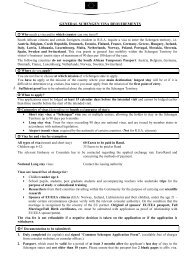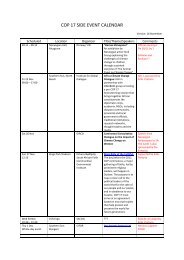Environmental impact management and planning: - Norway
Environmental impact management and planning: - Norway
Environmental impact management and planning: - Norway
You also want an ePaper? Increase the reach of your titles
YUMPU automatically turns print PDFs into web optimized ePapers that Google loves.
Developing a national environmental authorisation system as a web-basedelectronic database for EIA <strong>and</strong> other environmental authorisationsPurpose: To provide a system that indicates the status ofindividual EIA applications <strong>and</strong> information for strategic<strong>management</strong> decisions.OverviewThe National <strong>Environmental</strong> Authorisation System (NEAS)is a web-based electronic database that has beendeveloped to assist the South African governmentauthorities to capture, track <strong>and</strong> report EIA applications. Itis an integrated environmental <strong>management</strong> tool aimedat providing an environmental reporting mechanismat national <strong>and</strong> provincial level through the use ofcentralised information. The system has been designedto also h<strong>and</strong>le waste <strong>and</strong> air pollution, as well as all othertypes of environmental authorisations.The main aims of the system are to:• improve the processing of EIA applications;• track <strong>and</strong> report on the status of an application;• have database storage;• identify bottlenecks in the process;• generate reports <strong>and</strong> statistics on applications;• be a decision support system;• provide information for strategic <strong>management</strong>decisions;• integrate with other environmental systems; <strong>and</strong>• be flexible <strong>and</strong> adaptable to the changes inlegislation.ProgressNEAS has been fully developed <strong>and</strong> rolled out at all nineprovincial environmental authorities <strong>and</strong> the nationalDepartment of <strong>Environmental</strong> Affairs. The DEA is also providingassistance to provinces in terms of human resource capacityto capture the backlog of EIA applications on the system. Thedepartment is providing training to all users of the system.BenefitsNEAS provides benefits to all the relevant stakeholders interms of its ability to provide readily available background<strong>and</strong> historical information on a particular project or EIAapplication. The system also provides the current status ofthe application, together with the responsible official at everystage. In order to improve the processing of applications,NEAS is a process-driven system with time frames for everystage, as stipulated in the EIA regulations. For example,if a decision for an application is delayed by an officialusing the system, NEAS will send a notification indicatingthe delay in the process. Officials can record the numberof applications awaiting their response. Most importantly,the system is developed in such a way that the time frames<strong>and</strong> dates on which the application was received by thecompetent authority <strong>and</strong> the decision taken cannot betampered with. The NEAS database can also be exportedto a geographical information system (GIS) format to bedisplayed in map layers. This is currently being done.Possible further workNEAS Phase III entails the development of a public portalso that the general public can have access to the EIAapplications submitted to the environmental authorities.This will enable environmental assessment practitionersto track the status of their applications <strong>and</strong> informpotential developers of the project’s progress. The NEASdatabase can be exported to an ArcView reader GISapplication to display visual information in this regard.Additional environmental reports will be incorporatedinto the system to cater for the differing reporting needsof all the users.6







